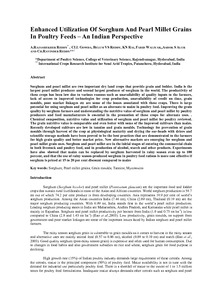Enhanced Utilization Of Sorghum And Pearl Millet Grains In Poultry Feeds – An Indian Perspective
Abstract
Sorghum and pearl millet are two important dry land crops that provide grain and fodder. India is the largest pearl millet producer and second largest producer of sorghum in the world. The productivity of these crops has been low due to various reasons such as unavailability of quality inputs to the farmers, lack of access to improved technologies for crop production, unavailability of credit on time, grain moulds, poor market linkages etc are some of the issues associated with these crops. There is large potential for using sorghum and pearl millet as an alternate to maize in poultry feed. Improving the grain quality by sorghum farmers and understanding the nutritive value of sorghum and pearl millet by poultry producers and feed manufacturers is essential in the promotion of these crops for alternate uses. . Chemical composition, nutritive value and utilization of sorghum and pearl millet for poultry reviewed. The grain nutritive value is comparable and even better with some of the improved cultivars than maize. Recently developed cultivars are low in tannins and grain moulds. Technology for prevention of grain moulds through harvest of the crop at physiological maturity and drying the ear-heads with driers and scientific storage methods have been proved to be the best practices that are demonstrated to the farmers for high grain quality and better market price. New alternative markets are emerging for sorghum and pearl millet grain uses. Sorghum and pearl millet are in the initial stages of entering the commercial chain in both livestock and poultry feed, and in production of alcohol, starch and other products. Experiments have also showed that maize can be replaced by sorghum harvested in rainy season even up to 100 percent, and that the use of rainy season-produced sorghum in poultry feed rations is more cost effective if sorghum is priced at 15 to 20 per cent discount compared to maize

